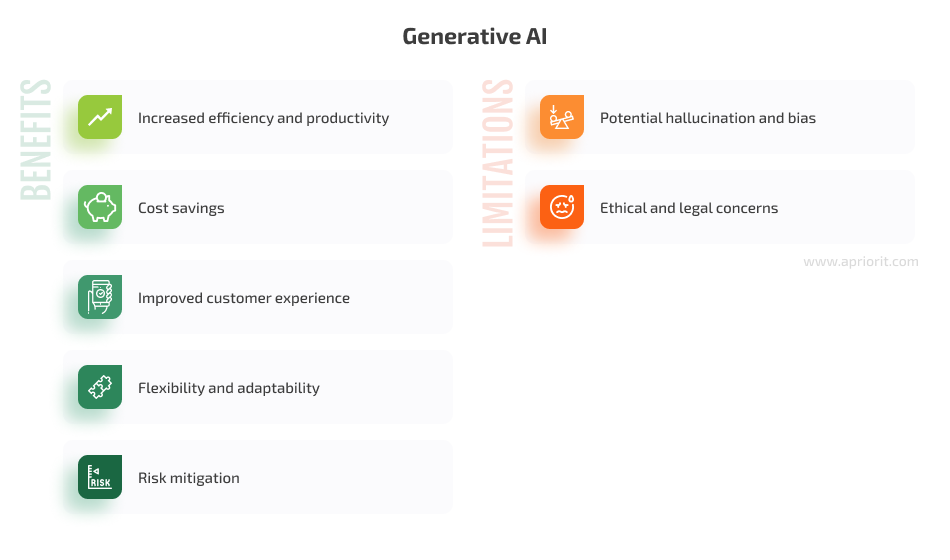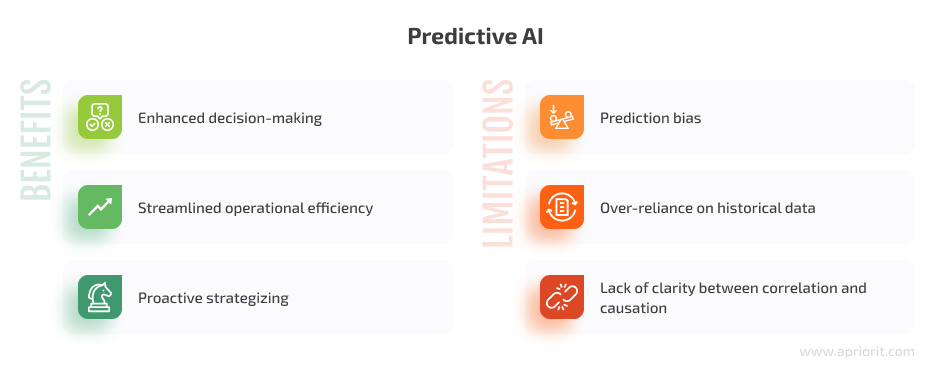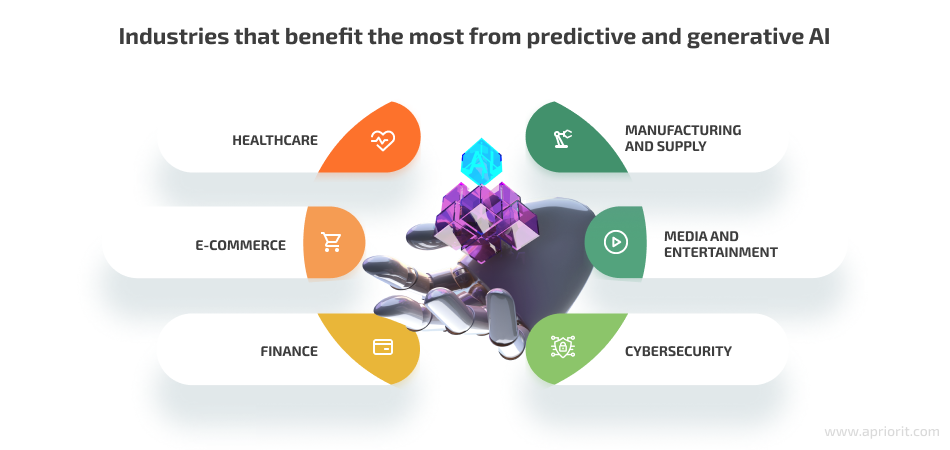Predictive AI and generative AI are the two types of AI that businesses most commonly consider when they want to outpace the competition and optimize processes. But although they may appear similar at first glance, their functions and applications are very different.
In this article, you’ll compare generative AI vs predictive AI and see which aligns with your industry and business needs. We’ll discuss use cases and also ways to combine generative and predictive AI into one powerful and advanced system.
This article will be useful to product specialists and tech leaders who want to power their software with today’s most advanced technology to achieve their business goals.
Contents:
Ready to harness the power of AI?
Reach out to us to choose the best AI solution for your use case, industry, and business goals, and level up your operations!
Both predictive and generative AI systems use advanced machine learning technologies to solve complex tasks. They can both make your business more productive, automated, and data-driven; however, they work in different ways and solve different challenges.
They have shared limitations, too. For example, the efficiency of generative and predictive AI is highly dependent on data quality as well as training, which can be resource-consuming and challenging. Both types of AI are also vulnerable to security issues.
At Apriorit, we optimize model architectures and training pipelines to reduce computational costs and enhance efficiency, allowing clients to deploy AI solutions faster and at lower cost.
We also implement robust security measures, such as anonymization or pseudo-anonymization, to protect sensitive information, ensure data privacy, and comply with regulations. This focus on cost-efficiency and data security ensures our clients receive high-performing, reliable, and secure AI solutions tailored to their specific needs.
Now, let’s look at the differences between generative AI and predictive AI in the work principles, capabilities, and limitations.
Generative AI: definition, benefits, and limitations
Generative AI, or GenAI, is a form of artificial intelligence that has gained traction in recent years with its impressive capability to create new content in various formats such as text, images, video, music, and software code.
How does generative AI work?
Generative AI models use a complex mix of machine learning, deep learning, neural networks, and vast amounts of data to recognize and analyze patterns. Then, they replicate these patterns by mimicking their structure or style. Some GenAI models generate new content based on prompts — requests that describe the desired result. Others, such as unsupervised models, generate content by learning the underlying data distribution without explicit prompts, creating new samples that resemble the training data.
There are several popular generative AI models that focus on specific tasks and content formats.
- Generative adversarial networks (GANs) generate images and videos, synthesize voices, and translate audio and video recordings.
- Variational autoencoders create new data samples similar to the data they’ve been trained on. These samples can be used as a training dataset for other GenAI models.
- Diffusion models generate images and videos using text-based prompts.
- Large language models generate text, imitate human conversation, write code, translate across languages, and perform data processing tasks based on prompts.
The most popular generative AI tools are:
- Gemini — an AI system by Google that specializes in creative text generation.
- ChatGPT — an AI system by OpenAI that can lead human-like conversations, generate code, and complete tasks according to prompts.
- AI-Writer — a tool for text generation.
- Microsoft Copilot — an AI system by Microsoft that assists programmers in software development, debugging, documentation creation, and more.
- codeStarter and Tabnine — tools for code generation.
- Midjourney and Stable Diffusion — tools for image generation.
- AIVA, Soundful, Boomy, Dadabots — tools for music composition.
Benefits and limitations of generative AI
Let’s examine the advantages businesses can gain from implementing generative AI in their products and the limitations they need to account for.

Benefits of GenAI include:
- Content creation automation. GenAI simplifies and automates tasks like content generation and coding, allowing users to focus on higher-value activities and save time.
- Cost savings. Generative AI reduces the need for manual labor in repetitive tasks, labor expenses, and operational overhead associated with content creation, data processing, and software development.
- Improved customer experience. By generating personalized responses and recommendations, generative AI provides fast and uninterrupted service on par with human support.
- Flexibility and adaptability. GenAI is able to handle diverse tasks and data formats, including unstructured data, which allows businesses to adapt their AI systems to new needs and market trends
- Reduced human error. Generative AI can automate tasks like generating reports and processing large volumes of data accurately and on time. This leaves more complex analytical tasks for humans, ensuring consistent and reliable results.
However, despite its many benefits, generative AI has limitations. They include:
- Potential hallucination and bias. Poorly trained and raw generative AI models tend to give inaccurate or misleading outputs, including hallucinated data or biased representations. This can undermine the reliability and trustworthiness of AI-driven systems and lead to flawed decisions or reputational damage.
- Ethical and legal concerns. Generative AI raises ethical and legal concerns related to privacy, intellectual property, plagiarism, etc. GenAI is a relatively new technology that isn’t yet highly regulated, so the legal environment may change.
Our AI engineers at Apriorit always consider these limitations when working with generative AI models. To address them, AI specialists make an extra effort to train models on high-quality data and use data according to the laws and regulations of a specific industry or region.
Read also
How to Build a Context-Aware AI Chatbot: Development Challenges and Solutions from Apriorit Experts
Build a truly smart chatbot for your customers! Learn how to create a context-aware chatbot that reflects your brand’s identity and brings customer service to a new level.

Predictive AI: definition, benefits, and limitations
In contrast to generative AI models, predictive AI forecasts events based on processed data. This type of AI has been around longer than generative AI, and businesses use it extensively to detect anomalies and make data-driven decisions.
How does predictive AI work?
Predictive algorithms rely on statistical techniques and machine learning to identify patterns, trends, and relationships in data. These algorithms and techniques include:
- Regression analysis to find correlations in data
- Decision trees to divide data into subsets based on features and simplify decision-making
- Support vector machines to classify data points
- Neural networks to find complex patterns and relationships in data
- Time series analysis to identify patterns, trends, and seasonality based on time-ordered data
- Ensemble learning to improve accuracy by combining multiple models
AI experts train these models on labeled datasets. Once trained, predictive AI models can generate predictions based on new data and thus enhance decision-making across a wide range of domains, including finance, healthcare, marketing, and manufacturing.
The most popular predictive AI platforms and services are:
- IBM Watson — a platform that offers various AI and machine learning services, including predictive analytics
- Amazon Forecast — a fully managed service that uses machine learning and statistical algorithms to predict future time-series data based on historical data
- Google Cloud — a large platform that has many tools for building, training, and deploying predictive AI models
- Salesforce Einstein — an AI-powered platform that provides predictive analytics and recommendations to enhance customer relationship management and sales processes
- Azure Machine Learning — a machine learning platform that allows organizations to build, deploy, and manage predictive models
Benefits and limitations of predictive AI
Now, let’s look at what your business may gain from predictive AI and the factors that you need to consider for successful implementation.

Benefits of predictive AI for businesses include:
- Enhanced decision-making. Predictive AI allows businesses to process large volumes of data and make informed decisions about strategy planning, resource allocation, etc. Insights from predictive AI also allow businesses to mitigate risks and identify new growth opportunities.
- Streamlined operational efficiency. Predictive AI saves significant time and money, as it can quickly analyze large volumes of complex, structured historical data. This allows users to get ready insights from data and immediately take action.
- Proactive strategizing. Predictive AI allows businesses to anticipate market changes, customer behavior, and emerging opportunities. Thus, they can adapt their strategies, optimize marketing campaigns, and capitalize on emerging trends to gain a competitive edge for their products.
Although predictive AI brings businesses significant value, it has its limitations, including:
- Prediction bias. Predictive AI models may amplify existing biases present in historical data, leading to biased predictions and decisions. This may lead to incorrect decisions and reputational damage to the business.
- Over-reliance on historical data. Historical patterns that predictive AI relies on may not always accurately reflect future trends or events. Yet, with the business environment continually changing, reliance on historical data may lead to inaccurate forecasts and decisions.
- Lack of clarity between correlation and causation. Predictive AI may identify correlations between variables without establishing causation, which may lead to misguided decisions and strategies.
To address these limitations, Apriorit AI engineers implement various strategies, such as bias detection and correction methods, adding real-time data streams to avoid relying solely on historical data.
Despite their differences, predictive and generative AI models can complement each other in many unexpected and creative ways. Let’s look at how you can apply these types of AI to your business separately and in tandem based on your industry and goals.
Read also
Starting a New AI Project: 12 Questions to Assess If You’re Ready
Become confident in your AI journey. Learn how to assess your need for AI, prepare for its adoption, and ensure your AI project is sustainable and profitable in the long run.
How you can use generative and predictive AI for your business: breakdown by industry
Although each type of AI broadly serves one primary function — generation or prediction — the practical use cases are nearly limitless and depend on the specific industry.
Let’s explore how different sectors can harness the power of generative and predictive AI to innovate, streamline processes, and stay ahead in the competitive market.

E-commerce
AI offers extensive possibilities to the e-commerce industry, especially in sales, marketing, and supply chain management.
Predictive AI analyzes historical sales data, market trends, customer behavior, purchase history, seasonality, and other factors to forecast future product demand and customer churn. This information allows e-commerce businesses to adjust supply and implement marketing strategies to retain and engage customers.
Generative AI can help personalize and scale marketing efforts by generating product recommendations and marketing materials based on a customer’s interests. Marketing materials generated by AI can help marketers experiment with messaging, conduct A/B testing, and determine optimal ways to communicate with the audience and increase customer engagement.
E-commerce businesses can also enhance their customer support with GenAI chatbots, as they understand natural language queries and can quickly assist customers.
Both types of AI can be combined within e-commerce marketing platforms and recommendation systems, with predictive AI being responsible for analyzing demand and generative AI being responsible for personalized recommendations, marketing materials, and direct communication with customers.
Healthcare
The healthcare industry extensively uses AI in diagnostics, treatment planning, and patient management.
Healthcare businesses use a lot of real-time and historical data to forecast disease outbreaks and patient readmissions using predictive AI. This is a great way to predict future demand for healthcare facilities and specialists, identify high-risk patients or groups, and reduce hospital readmission rates.
Paired with image processing algorithms, predictive AI can analyze medical images like X-rays, MRIs, and CT scans to detect early signs of disease.
Generative AI can help train such solutions by creating synthetic medical images for training image recognition models.
Other generative AI use cases in healthcare include creating personalized treatment plans and assisting pharmaceutical companies in discovering new drugs quicker and more cost-effectively.
Healthcare businesses can leverage the combined power of generative and predictive AI within a patient management system. In such a system, predictive AI forecasts patient admission rates and identifies potential health conditions, while generative AI writes personalized treatment plans based on predicted conditions.
Related project
Building an AI-based Healthcare Solution
Learn how Apriorit accelerated and simplified doctors’ routines by building an AI-based system that could track, detect, and measure ovarian follicles with astonishing accuracy using video footage.
Manufacturing and supply chain
In the manufacturing and supply chain industries, companies can use AI to anticipate demand, optimize supply chains, and control manufacturing quality.
Just like in the e-commerce domain, manufacturing and supply chain businesses can use predictive AI to efficiently predict demand and optimize inventory management accordingly. In addition, predictive AI can analyze data from equipment sensors and maintenance logs to predict equipment failure, schedule maintenance activities, and purchase maintenance supplies before equipment malfunctions and hinders the manufacturing process. Data created by generative AI can be used to train predictive models.
Generative AI can also design and optimize supply chain networks, distribution routes, and inventory management strategies to minimize costs and improve supply chain efficiency.
Finance
The financial sector uses AI to assess risks and make business decisions.
Predictive AI analyzes historical price data, trading volumes, individual credit history, unemployment rates, and macroeconomic factors to make the best decisions in the volatile financial market. Predictive AI can also detect fraud by analyzing malicious patterns from past incidents.
Generative AI can simulate market scenarios and perform stress testing for risk models by generating adverse scenarios that challenge the financial system’s resilience and stability. Generative AI can also create synthetic financial data to train financial risk models without exposing real sensitive data. Insurance businesses can use GenAI to automate claims processing, generate documents such as insurance policies, and assess damages.
Combined, generative and predictive AI modules can be parts of smart systems for risk assessment stock price forecasting. Predictive AI forecasts stock prices or a lender’s trustworthiness, while generative AI stress tests risk models and compiles efficient risk mitigation strategies.
Media and entertainment
The media and entertainment industry mostly uses AI to create content and analyze audience reactions.
Predictive AI can forecast media trends and anticipate viewer reactions based on historical and real-time data from social media, critical reviews, viewer ratings, etc. This can help media companies make decisions about producing and marketing their content.
Generative AI can enhance content development and create personalized materials based on user preferences, viewing history, and demographics. In the gaming industry, generative AI is extensively used in character design and game asset generation.
By combining generative and predictive AI within a content generation system, media companies can deliver tailored content for their audiences and maximize engagement. Gaming studios can build asset generation systems that pair generative AI with predictive AI’s analysis of player behavior and preferences. As a result, studios can provide highly personalized and engaging gaming experiences, leading to increased player retention and satisfaction.
Cybersecurity
Cybersecurity companies use AI to detect threats, manage risks, and prevent malware attacks.
Predictive AI can analyze and monitor network traffic, system logs, and security events to identify abnormalities and potential vulnerabilities, and can even predict future cyber risks and threats based on threat intelligence and attack patterns. This allows businesses to detect risks early and implement security measures before they escalate into full-blown cyberattacks.
Generative AI can simulate cyberattack scenarios, such as phishing attacks and ransomware incidents, to test an organization’s resilience against real-world threats. This allows organizations to evaluate their cybersecurity defenses, identify weaknesses, and improve incident response capabilities.
Cybersecurity businesses can combine predictive and generative AI within threat intelligence platforms, cybersecurity defense systems, and endpoint detection and response (EDR) solutions. In such products, predictive AI anticipates risks and monitors systems, while generative AI simulates realistic attack scenarios and malware variants to enhance the resilience of security systems and identify vulnerabilities before hackers do.
Read also
Implementing Artificial Intelligence and Machine Learning in Cybersecurity Solutions
Predict and prevent threats with AI. Learn how you can power your cybersecurity solution with the most advanced technologies available to date and bring top-notch security to your customers.
How Apriorit can help you adopt AI
At Apriorit, we have real experience in delivering both generative AI and predictive AI solutions for our clients. Our experts can help you choose the perfect technology for your needs, integrate it into your software, and complete a full spectrum of AI-related tasks, including:
- Custom AI solution development. If your product has unique requirements or is intended for a highly regulated industry, our engineers can build an AI system from scratch. We can also build your solution using an existing model and train it with your data.
- AI model fine-tuning. We can customize a pre-trained AI model like GPT according to your needs and ensure its output is consistent and reliable. We employ advanced techniques such as hyperparameter optimization, transfer learning, and regularization to fine-tune model parameters and optimize their accuracy, precision, and recall.
- Preparing custom datasets. Training an AI model to do specific business tasks requires a custom dataset. Most businesses already have all the data for training but need to turn that data into a quality dataset. Our AI development team can help you collect, structure, and label data for algorithm fine-tuning. We can also leverage generative AI to create high-quality data to fill in missing data entries.
- AI security testing. We conduct thorough security assessments to identify vulnerabilities and ensure your AI models are protected against threats. Our team performs adversarial testing, penetration testing, and vulnerability scans to safeguard your AI systems from attacks, ensuring the confidentiality, integrity, and availability of your data and models.
- AI service integration into your current infrastructure. Our AI development specialists can integrate an AI service into your current infrastructure, so it works seamlessly with your existing workflows and systems. We will ensure compatibility, scalability, and interoperability with your current technologies and applications, whether they’re cloud-based or on-premises.
Examples of such integrations include:
- GPT-4 for advanced natural language processing tasks such as customer support automation, content generation, and data analysis.
- TensorFlow models for image recognition and classification, enhancing your computer vision applications in fields like healthcare and retail.
- IBM watsonx for predictive analytics and decision support systems, enabling data-driven insights across various business functions.
- Azure AI Services for integrating AI capabilities like speech recognition, language understanding, and anomaly detection into your existing applications.
- Amazon SageMaker for building, training, and deploying machine learning models at scale, perfect for tasks such as fraud detection or personalized recommendations.
Apriorit offers comprehensive support in building AI products tailored to your unique requirements. Whether integrating existing models or developing solutions from scratch, we approach every project with a security-first mindset. By working with us, you can be sure that your data and users’ privacy are prioritized and safeguarded at every stage.
Conclusion
Generative and predictive AI are two distinct types of artificial intelligence that serve different purposes and have their own particular use cases. Both can help you optimize business operations, open new opportunities, and gain a competitive edge.
You can also combine generative AI and predictive AI to maximize your software’s capabilities and create a unique solution for your particular use case.
Apriorit’s AI engineers can help you choose and implement the perfect AI solution for your idea, no matter how niche it is. Our specialists have experience building both generative AI and predictive AI products and integrating AI functionality into software for healthcare, cybersecurity, logistics, and other industries.
Need an experienced team of AI engineers?
Get access to a pool of AI specialists who have delivered dozens of smart, secure, and efficient solutions to businesses in multiple domains!


